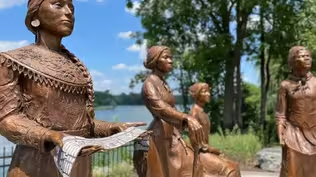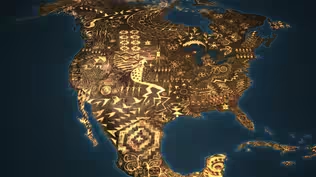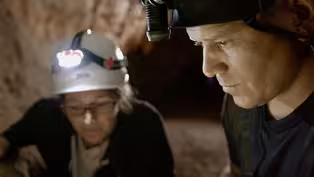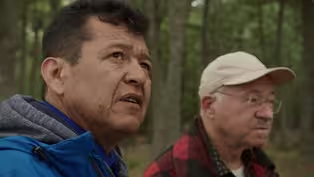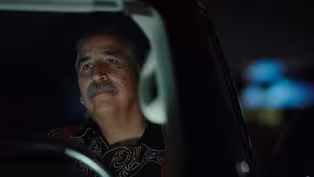
Language Is Life
11/14/2023 | 53m 25sVideo has Audio Description, Closed Captions
Experience the fight of Native Americans to keep their languages and ways of life alive.
Celebrate the power of Native languages and the inspirational people who are saving them. From secret recordings to "Star Wars" films dubbed in Navajo, follow the revolutionary steps transforming Native America.
See all videos with Audio DescriptionADProblems playing video? | Closed Captioning Feedback
Problems playing video? | Closed Captioning Feedback
Funding is provided by Partnership with Native Americans.

Language Is Life
11/14/2023 | 53m 25sVideo has Audio Description, Closed Captions
Celebrate the power of Native languages and the inspirational people who are saving them. From secret recordings to "Star Wars" films dubbed in Navajo, follow the revolutionary steps transforming Native America.
See all videos with Audio DescriptionADProblems playing video? | Closed Captioning Feedback
How to Watch Native America
Native America is available to stream on pbs.org and the free PBS App, available on iPhone, Apple TV, Android TV, Android smartphones, Amazon Fire TV, Amazon Fire Tablet, Roku, Samsung Smart TV, and Vizio.
Buy Now
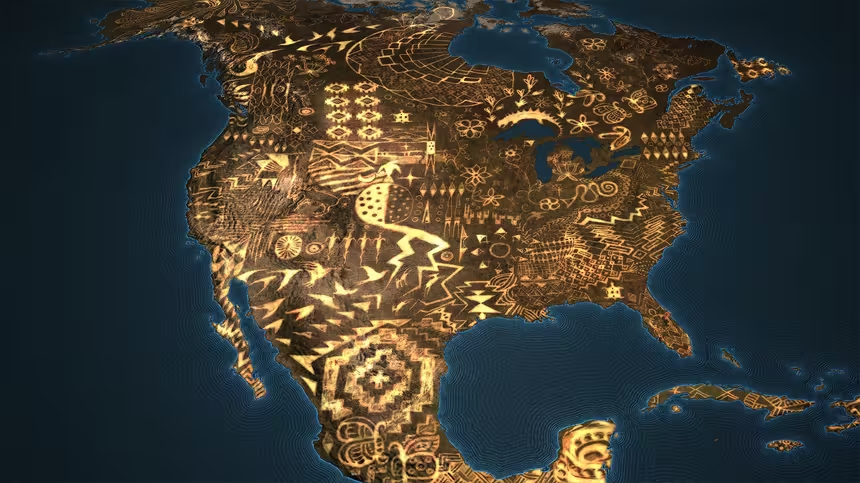
Listen to Native Voices
Explore an interactive map, which features speakers of Native languages in their own voices from across North America.Providing Support for PBS.org
Learn Moreabout PBS online sponsorshipNARRATOR: From Hollywood films on the big screen... OBI-WAN KENOBI (in Navajo): (explosion echoes) NARRATOR: ...to sacred writing deep within the Earth...
BEAU CARROLL: Now there's a word here.
(man singing on recording) NARRATOR: ...to long-lost voices captured in wax... SEANA MACKELDEY: That's us, we're still here.
NARRATOR: ...we as Native peoples are fighting to keep our languages and ways of life alive.
MADONNA SOCTOMAH: Language is who I am.
NARRATOR: This is "Native America."
♪ ♪ ("Binary Sunset" playing) NARRATOR: May the Fourth is a special night at the West Winds Drive-In in Glendale, Arizona.
♪ ♪ GERI HONGEVA: I'm always so excited for May the Fourth Be With You.
Every year when this comes around, my energy level goes up.
(talking in background) There you go.
NARRATOR: Tonight, they're screening a unique version of "Star Wars"-- dubbed into Navajo.
♪ ♪ BILAGODY: When I heard that folks were going to do Episode IV in Navajo language, it was a dream that came true.
♪ ♪ The teachings, like, Yoda would say things that I heard while I was a little boy-- the connection was strong.
Thank you.
♪ ♪ CLARISSA YAZZIE: It is said that our language is dying, you know?
We're forgetting our language.
But I'm still hopeful that, you know, there are going to be kids that are gonna get inspired and excited about, you know, "I want to learn the language."
HONGEVA: It's a great deal for me because my grandparents can see this movie.
There are a lot of elders in our community where Navajo is the only language they know.
JONATHAN NEZ: Ladies and gentlemen that are listening in your cars this evening here at the drive-in theater, the Navajo language is on a comeback.
(speaking Navajo): ("Main Theme" playing) ♪ ♪ LUKE (speaking Navajo): (movie audio continues) MANNY WHEELER: Everybody loves "Star Wars"-- I remember seeing a toy X-Wing fighter, probably 1978, '77, you know, and, like, just really being blown away.
That was my first introduction to "Star Wars."
I didn't even know about the movie, I just saw this toy, and I was just, like, "Whoa!"
NARRATOR: Manny Wheeler is the Jedi mind behind the Navajo dub of "Star Wars."
He auditioned hundreds of people to bring the project to life.
LEIA: Help me, Obi-Wan Kenobi.
(speaking Navajo): (speaking Navajo): Obi-Wan Kenobi.
Obi-Wan.
(speaking Navajo): LUKE (speaking Navajo): OBI-WAN (speaking Navajo): WHEELER: The Force and the universe is all interconnected.
When you put that in the Navajo language, especially for an elder to hear that, they're going to just be thinking, like, yeah, of course.
It's not just a movie.
That's stuff we, we really believe.
OBI-WAN (speaking Navajo): WHEELER: When you have an understanding of Navajo, you're connected to a deep culture.
You're connected to the holy people, that's what we call them.
And you have a strong sense of being in this world when you are fluent in Navajo.
♪ ♪ OBI-WAN (speaking Navajo): IMPERIAL OFFICER (speaking Navajo): (explosion echoes) WHEELER: The vast majority of our speakers are older.
They're either my age or older.
And it doesn't take a scholar to see the road that we're heading down.
We need to put things in place immediately to prevent our language from vanishing.
(chant set to techno music playing) NARRATOR: The urgency to keep Native languages alive is experienced by many tribes across the country.
(music continues) MAN (speaking Anishinaabe): (music continues) (drum playing, woman singing) NARRATOR: In Maine, at the most northeastern place in the United States, the struggle to keep language alive is deeply connected to the land.
Donald Soctomah is the Passamaquoddy tribal historic preservation officer.
(song continues) And Dwayne Tomah is the director of the Passamaquoddy Museum.
(speaking Passamaquoddy) NARRATOR: They're on their way to a place they call Kuwesuwi Monihq-- Pine Island.
TOMAH: Our people have always had names for these islands.
And that particular island's always been Kuwesuwi Monihq to our people.
Yeah.
DONALD SOCTOMAH: 500 years ago, we'd be seeing probably a group of birch bark canoes.
The fish would be jumping out of the water.
It was a happy place.
A place that sustained our people.
That's right.
(hawk calls) NARRATOR: For thousands of years, Kuwesuwi Monihq was part of the Passamaquoddy's homeland.
A 1794 treaty with the newly formed United States government recognized the Passamaquoddy's ownership.
♪ ♪ This island was supposed to be protected forever.
DONALD SOCTOMAH: But the island's name was changed.
So it was no longer Pine Island as listed in the treaty.
All of a sudden, the name of the island was White's Island.
NARRATOR: The government of Maine changed the name of the island so it wouldn't match the name on the treaty.
The government used language to steal the land from the Passamaquoddy.
We're pretty lucky today, the eagles left us a gift.
(chuckles): Yeah.
It's really nice to be back here.
DONALD SOCTOMAH: About 100 years ago, when our people were taken off this island... Hm.
...the loggers came in here and just stripped the island clear of all the pine trees.
TOMAH: Hm.
DONALD SOCTOMAH: Stripping it of its very name.
TOMAH: Yeah.
This is the site of our old village.
Yeah.
On Kuwesuwi Monihq.
I can feel their spirits.
It's powerful here.
Yeah.
♪ ♪ DONALD SOCTOMAH: This is the center of the lake, our life.
Yeah.
NARRATOR: For the Passamaquoddy, land and language are intimately connected.
And both are under attack.
Donald and Dwayne are on a mission to keep the language alive and get this island back.
(singing in Passamaquoddy) (continues singing) NARRATOR: They will be aided by a remarkable discovery.
MAN (on recording): Vocabulary from the Passamaquoddy Indians, March the 15th, 1890.
(Noel Joseph speaking Passamaquoddy) ♪ ♪ WOMAN (speaking Passamaquoddy): NARRATOR: The voices on those 130-year-old recordings could help save the Passamaquoddy language.
Dwayne wants to find them.
You are the youngest fluent speaker of the tribe.
Your pronunciation is excellent and your knowledge of the language is so important.
You have to listen to our ancestors.
I believe this is going to be your journey.
Mm.
NARRATOR: Dwayne grew up speaking Passamaquoddy in his home.
But for many in his generation, Native language was discouraged, or outright banned.
♪ ♪ WHEELER: My generation had plenty of parents that spoke Navajo fluently, but they didn't pass that language teaching on to us.
And that's where I start to feel strongly and I start to feel motivated that we need to put things in place immediately to prevent our language from vanishing.
NARRATOR: In 1980, 93% of Navajos spoke their language.
Today it's down to half.
RUTH ROANHORSE (speaking Navajo): NARRATOR: Manny wants to know how some who do speak the language are keeping it alive.
He's coming to visit Sophie Shorty and her family: mother Ruth, Sophie's daughter Autumn, and Autumn's daughter Kristy.
ROANHORSE AND SHORTY: NARRATOR: Four generations of Navajo speakers.
(Roanhorse laughing) AUTUMN: Gee!
You're better than me, yeah?
ROANHORSE: SHORTY (speaking Navajo): SHORTY AND ROANHORSE: (dog barking) (Wheeler greeting) (talking in background) WHEELER: Mm, looks delicious.
(exhales): I just came back from, um, Phoenix.
We, uh, showed the Navajo "Star Wars" down there.
And it was pretty good, it was at a drive-in.
ROANHORSE: Oh, yeah, I've been to one, they... We went to a drive-in, but we were in the trunk.
We went to the... (all laughing) No.
Then we got out until we, we parked.
WHEELER: Mm-hmm.
NARRATOR: It's easy to understand how Sophie and her family keep the language alive.
Every day they live it.
"Hang 'Em"... "Hang 'Em High"... (speaking Navajo) NARRATOR: But what about those who are losing the language, including Manny?
WHEELER: I look to the reasons that my parents didn't teach it to me.
And that, that's a real sensitive, um, discussion.
WHEELER: My parents, they both speak Navajo and, um, they both went to boarding school.
But they never talk about it.
They never said, like, "Well, we were beaten," or, "We were punished for talking our language," but it probably was like that.
Like, when you think about a chain, that boarding school broke one of the chains that was our language, you know?
Hm.
SHORTY (speaking Navajo): (laughs) Oh... (speaking English): There were certain boys that used to tease me.
To this day, I know their kids.
I had them as my students.
WHEELER: Hm.
And, um, I think those people who had kind of stepped away from the Navajo language later realized, "I want that, I need that."
Mm-hmm.
I've seen kids, you know, getting bullied because they talk Navajo.
When I was little, when my classmates were talking Navajo, we used to call them Johns, you know?
And, um, I feel bad that that happened, you know?
Um, I feel bad that I, I was part of it.
So, you know, all of that, I'm trying to fix it.
♪ ♪ NARRATOR: The wounds of language loss are deep and personal.
The major reason for Native American language loss is U.S. government policy designed to destroy Native American cultures.
The vehicle for that was boarding school.
The goal, stated by Captain Richard Henry Pratt, one of the chief proponents of the policy, is, "Kill the Indian in him and save the man."
♪ ♪ MAN (speaking Kiowa): (scissors clip) (fire crackling) (belt strikes, boy grunts) NARRATOR: Between 1890 and the 1960s, it's estimated over 150,000 children were taken from their families and forced into U.S. government, Catholic, and Christian boarding schools.
Thousands of children died while there.
Those numbers are increasing as mass graves are still being found today.
Recovering language is an important step in healing from historic trauma.
♪ ♪ MAN: Shall we go to the vaults?
TOMAH: Yeah, absolutely.
I'm really, really excited-- very, very excited.
Yeah.
Yeah.
NARRATOR: Dwayne Tomah's search for the voices of his Passamaquoddy ancestors brings him to the National Audio-Visual Conservation Center.
It houses the world's largest collection of early sound recordings of Native American languages.
♪ ♪ The earliest field recording is spoken in Passamaquoddy and captured on one of the first recording mediums, wax cylinder.
These here, these are all Passamaquoddy cylinders recorded in 1890.
TOMAH: Oh, my God, wow.
They titled that "The Salutation," but at that time, they really didn't realize what they had.
They obviously didn't know what, what they were saying.
Mm-hmm.
So as a fluent speaker, I'm able to identify the content.
That's great.
NARRATOR: But the wax cylinders are extremely fragile.
And there's no guarantee the voices recorded on them have even survived.
MAN (on recording): Now, the phonograph is a talking machine.
It was invented by Thomas Alva Edison, a native of New York.
(quickly): You can talk into it as fast as you like.
(slowly): Or you can speak as deliberately as you choose.
In either case, it reproduces exactly what you say.
NARRATOR: These recordings were made in 1890, the same year as the last military campaign to wipe out Indians, Wounded Knee.
(guns firing faintly) There, the U.S. Army murdered over 250 Native men, women, and children.
At the time, the expectation was that Indians would either be exterminated or assimilated.
♪ ♪ So a wave of anthropologists set out to document as much as they could on Native American cultures and languages before they were totally wiped out.
MAN (on recording): Snake song and description by Noel Joseph of the Passamaquoddy tribe, in Calais, Maine, on the 18th of February, 1890.
NARRATOR: The sound quality has diminished over the last hundred-plus years.
But the technology to recover that sound has greatly advanced.
Melissa Widzinski is an audio technician specializing in a machine called Endpoint that uses a laser-assisted needle.
So, the first step is looking at the cylinder itself.
Cylinders over time can develop different issues, uh, like cracking or warpage.
Mm-hmm.
And I'm turning it like this, um, in my hands as I'm holding it because cylinders are very sensitive to temperature.
Hm, mm-hmm.
And if I keep it in one place for too long, the heat from my hands might cause a crack.
So... Oh, that's amazing.
We try to be very, very careful when we handle these.
Mm.
So let's give this a listen.
(Joseph singing on recording) (singing continues) (singing continues) TOMAH: It's "Athusossuwewakon."
"Athusossuwewakon" is a snake dance song.
Wow.
And not only that, but we have a snake dance song, but it's not the same song.
Mm-hmm.
So now, we're going to bring back the original "Athusossuwewakon."
(Joseph singing snake dance song) TOMAH: The snake dance song has evolved over time.
But the, the teachings that are in the songs are still there.
The idea of coming together, about unity, about sharing common problems, are still woven like a basket into the song.
♪ ♪ What I'm going to do now is to continue to carry the voice of my ancestors.
(voice trembles): That's exactly what I'm going to do.
Their voices will not be on a shelf.
I'll continue to do the work that they wanted me to carry out and for all of us to carry out.
To preserve language and songs, because that is our worldview.
It's how we see the world.
♪ ♪ (birds chirping, water rushing) NARRATOR: Hidden beneath the thick forest canopy of the Smoky Mountains lies another, very different kind of archive: a cave containing some of the earliest evidence of Cherokee writing.
(door closes) Eastern Band of Cherokee Indians archaeologist Beau Carroll and Cherokee Nation citizen and historian Julie Reed are returning here to document the writing.
They're hoping it can help them understand a pivotal moment in Cherokee history.
I'm always thinking when I go in there that, how dangerous it is sometimes, some of the stuff we have to go through.
Mm-hmm.
And then I think that our ancestors, they didn't have safety equipment.
Yeah, I mean, I think about the engineering that's required to get to some of the spaces that they go to, and yet here they are going to these spaces hundreds of years ago, thousands of years ago.
♪ ♪ REED: I was asked to come look at some caves that may have writing in them.
And as a Cherokee historian, I was more than happy to see where these sites were and exactly the context that they existed in.
CARROLL: Once you go into the ground, like, in a cave, you're passing through a portal and you're going into another world.
REED: The age of these spaces.
These are the old, old mountains that predate our ancestral Cherokees, and yet here we are in these old spaces doing something incredibly innovative and new.
CARROLL: It's amazing to cross through this threshold and then having that aspect of that danger.
It makes it that much more, I guess, important and special for me.
Beau made it look so easy.
♪ ♪ CARROLL: Whenever I come in a cave, I feel like the Cherokees that were in here writing wrote it right before I came in, like, yesterday.
(laughs) REED: I sit in archives all day long, I go to libraries, and yet, to think about this space as an archive, right?
And, like... CARROLL: Oh, yeah.
When you come in here, this is the first thing that you notice.
REED: Yeah.
CARROLL: This graffiti.
But if you look a little bit closer, you start seeing, teasing out these little syllables that run out through here under this.
So I'm gonna grab the camera, and we can...
Okay.
...take some more pictures.
(switch clicks) NARRATOR: Beau and Julie believe this is one of the earliest examples of Cherokee writing.
But before they can begin to decipher it, they must find a way to distinguish it from a modern layer of graffiti covering it.
CARROLL: If you could move a little bit to your left, we can get those shadows out.
NARRATOR: Fortunately, there's an app for that.
Okay, Julie, I got it pulled up.
So, we take this original photo, put it in the DStretch, and then pull that black out.
And then something like that... REED: Mm.
CARROLL: Then it pulls out those, the syllables under that B and R that we couldn't see before.
So, it looks like now, there's a word here and then another word here.
REED: Yeah.
NARRATOR: They use an image processing technology called DStretch to see through layers of vandalism.
REED: That stuff under there is the stuff I thought looked like... NARRATOR: The markings in the cave date back over 200 years, to a time of tragic upheaval for the Cherokee.
♪ ♪ For thousands of years, they lived in the southeast part of the United States.
But in 1838, they were forced to relocate to Indian Territory, present-day Oklahoma.
Their thousand-mile walk through bitter cold, a painful journey shared by four other tribes, became known as the Trail of Tears.
More than 10,000 people died along the way, including 4,000 Cherokee.
Foreseeing U.S. attempts to wipe out Native cultures, a man named Sequoyah came up with a revolutionary technology to fight back: a writing system called a syllabary.
Until then, Cherokee was only a spoken language.
THOMAS BELT: Sequoyah began developing the syllabary in about 1807, and it wasn't completed until 1820.
He worked on it singlehandedly, not having a formal education.
He was simply a person who was really concerned about being able to use marks on a piece of paper, just like the Americans were doing.
Think we're done?
Mm-hmm, yeah.
Yeah.
All right.
NARRATOR: Beau and Julie need to consult with Tom to help translate the writing.
(switch clicks) UNCLE OWEN (speaking Navajo): C-3PO (speaking Navajo): UNCLE OWEN: (Jawa speaking) UNCLE OWEN: WHEELER: When Navajo "Star Wars" first came out, I thought that would be the only one and that was it.
I never thought, "We're going to do more."
("A Fistful of Dollars" theme playing) And then I really started to get a lot of people saying, "You should do a Western."
(music continues) (gun fires, horse galloping) But out of those thousands of Westerns that were done, which one would we do?
(horse whinnying on computer, film music playing) (fires) Native people in Westerns, we have a history of being misrepresented, either by portraying us as primitive... See what I told you?
WHEELER: Or as being vicious and violent.
(guns firing) Wendigo getting away.
(whispering): What the hell's he talking about?
Nothing, it's an Indian thing.
("A Fistful of Dollars" theme resumes, gun fires) WHEELER: But Clint Eastwood Westerns, they're great films and they're great stories, and in this case, in "A Fistful of Dollars," there were no Native people in it.
♪ ♪ (singing indistinctly) Get three coffins ready.
Huh?
(chuckling, imitating coffin maker) NARRATOR: Manny assembles a group of trusted colleagues to translate the film.
Listen, stranger, did you get the idea?
We don't like to see bad boys like you in town.
Go get your mule.
(others laughing) I don't think it's nice, you laughing.
Let's stop it right there.
(movie pauses) So that part, like, in our own language, how do you think you would say that part?
Like... You see?
That's what I wanted to talk to you about.
"He's feeling real bad."
What I would say was... (speaking Navajo): (in English): I would've said that.
ANDY HARVEY (speaking Navajo): JOE KEE: Just that one phrase, "He's feeling real bad," the actor on screen has his mouth like this, "ees," so his teeth are showing.
So we have to find that specific word, to where, uh, the Navajo word will also allow the teeth to show.
WHEELER: A non-Native person might say, like, "Why should language matter?"
You know?
"That's just how the world is."
KEE: And then we'll... WHEELER: My response to that would be, "All our cultures enrich each other."
You're doing really good, so let's go to the next line.
There are three sections.
(speaking Navajo): SHAWN JIM: Okay.
Go ahead.
(beeping) (Jim speaking Navajo) KEE: It's a little bit long.
Oh.
So we need to read it a little bit faster.
So let's do that again hot, because...
Okay.
(beeping) (Jim speaking Navajo) So now that you have the sounds down, we also have to mimic the character to where we can stick maybe a pretzel in your mouth, or a stick.
JIM: The process of translating the English script to Navajo was very extensive.
(speaking Navajo) It did take time in order for all the words to fit carefully.
It had to be precise.
(speaking Navajo): (film music playing) (firing) (horse whinnying) NARRATOR: Manny hopes dubbing "A Fistful of Dollars"-- the iconic Spaghetti Western-- will help reach a larger audience and inspire even more Navajo people to speak their language.
(speaking Navajo): ♪ ♪ (rain falling) NARRATOR: In Calais, Maine, Dwayne Tomah returns to the very spot where, in 1890, the original wax cylinder recordings of his ancestors were made.
TOMAH: When I look at this picture, I think about what the people are thinking.
They were thinking way ahead, knowing that the language and songs were going to be preserved.
It means so much to me, knowing that our language and songs and stories will continue.
(man singing) ♪ ♪ NARRATOR: Dwayne has brought the recordings home.
(Joseph singing snake dance song on recording) NARRATOR: At the Waponahki Museum, community members hear the restored snake dance song for the first time.
(recording playing) (recording playing) TOMAH: It brings me home.
It brings me back, to my childhood.
I could hear my grandmother speaking in the language.
And also, it brings me back to a time where the language was spoken so fluently.
MARGARET APT: When I first heard that, I thought, "Oh, my God."
Hearing the voices of our ancestors, they're sending us messages.
And they have lessons for us, and it's just an indescribable, uplifting feeling to have heard them for the first time.
When I was a child entering school, I did not speak English.
I only spoke Passamaquoddy.
We had a sense of self.
We knew who we were.
And when I feel sad, it's because I've seen the loss.
Language is who I am.
I moved away from the community, uh, and raised my children outside the reservation.
My son David never learned the language.
When I hear the recordings, I remember his words.
(voice breaking): David said to me, "Mom, why didn't you teach me how to speak?"
And when I hear this, I think, "Oh, my gosh."
(sniffs) (exhales) It's so ironic that the dominant culture seeks to continuously wipe us out and to make us like them, and it's their own technology that has brought us over 100 years into our past.
And to hear people that we're all related to speaking, and to listen to that song, and to hear, like...
I wanted to dance.
DONALD SOCTOMAH: These cylinders come back at a crucial time in our cultural history.
They're all so powerful and the words come right out.
For so long, our, our language has been demonized.
Now the energy's coming back, and these cylinders are part of that renewal.
They sat for so long in these warehouses, just waiting for us.
MACKELDEY: It's so amazing.
And just to hear that, because that's, that's us.
We're, we're still here, and we're still, we're going to sing those songs, and because of these recordings, they're going to go on, and in 100 years, there's going to be people that hear you guys.
Mm-hmm.
And we're going to give that connection to somebody else that needs it.
(recording playing) (thunder rumbling) (recording fades out) ♪ ♪ NARRATOR: Over 200 years ago, a Cherokee person created another kind of technology to speak to his future descendants-- a writing system.
Julie Reed and Beau Carroll are trying to decipher what that ancient writing says.
(speaking Cherokee) NARRATOR: They seek the advice of Cherokee elder Tom Belt, a fluent speaker and expert on the Cherokee writing system.
I want to show you the, the pictures we got from that visit to the cave.
Now we can see that bottom line pretty clear.
So the first two things that stand out are the two syllabary letters sa and sa.
That would be someone's name, Sa Sa, which means goose.
NARRATOR: Tom believes Goose is the name of the writer.
BELT: The next thing we were looking at, then, would be the O-Tsi-Wa-Ta-Na.
O-Tsi-Wa-Ta-Ni.
And that word in Cherokee, that means, "We found it."
CARROLL: Is that right the A right here?
BELT: Yeah.
(sounding out word) Yeah, yeah.
(Belt repeating word) "That that was asked for, we have found it, and it has been divided."
NARRATOR: But what has been asked for and divided?
What does that mean?
In that time, the changes that were being faced by the tribe were immense.
The issues of total removal from our homelands.
WOMAN (speaking Cherokee): ♪ ♪ BELT: The meaning behind the writing was to let people know that this issue had been resolved.
It could be that three captives were taken to balance out three captives that had been taken from them.
Or it could be that lives had been forfeited.
NARRATOR: But why would Sa Sa, Goose, the author of this 200-year-old phrase, go into a dangerous cave to write these words?
BELT: I think that this writing in the caves... ...says that this had to be something that was well-documented.
It is, in fact, the way in which they documented that this issue had been settled.
Mm-hmm.
You know, it's done, it's over with, let's move on, it's been healed.
♪ ♪ They would go to these caves and do those ceremonies in order to establish a sense of mental health.
NARRATOR: The cave is both an archive for settled law and a place to go for healing.
The syllabary is the technology that records that language.
BELT: The accumulative volume of information about all of the aspects of what it means to be a human being is encoded in the language.
It is simply the way in which we interpret the world.
If we lose these languages, we're losing an accumulated knowledge of human existence here, over thousands of years.
(singing in Passamaquoddy) NARRATOR: Language is more than words.
Language defines life.
(singing) NARRATOR: On June 21, 2022, the Passamaquoddy and friends gather on Kuwesuwi Monihq-- Pine Island.
(song continues) NARRATOR: The island and its name is being restored to its rightful caretakers.
(song continues) NARRATOR: Its return is not a magnanimous gesture from the government.
The Passamaquoddy had to buy it back.
The ceremony honors the many people who came together over decades to make that possible.
(song continues) (song ends) This island coming back to our community is so important.
It's like the wax cylinders that have come back to us after 125 years.
DONALD SOCTOMAH: To me, this is one of the most significant moments in modern history.
This island is part of our DNA.
This island and the rest of the land are going to come back to our children and their children.
MAGGIE DANA: I've never been on this island, so, just being here, it brings up a lot of things for us, for me.
And I think about our culture.
We're, um... (clears throat): Just trying to survive.
And, you know, I try to think of the future, and, just what does that look like?
This is a good step for our people.
DONALD SOCTOMAH: I'd like to have Dwayne do a wax cylinder song, just to acknowledge the ancestors that have come back, that forever we thought was gone.
TOMAH: This is an old archaic song.
It was documented 130 years ago.
But it's our contention that these songs have been here a lot longer than that.
(singing in Passamaquoddy, shaker rattling) TOMAH: Our people knew, because of this recording, these songs and stories would not be lost.
(song continues) NARRATOR: The land and the voices of the people come full circle.
The island, stolen from the Passamaquoddy, has been returned, its name restored from White's Island to Pine Island.
And the voices of the Passamaquoddy ancestors, recorded on wax to document a dying language, are alive and being sung today.
(song continues) (Tomah speaking Passamaquoddy) If you know where you come from, you'll know where you're going.
(song continues) DONALD SOCTOMAH: I believe this Land Back movement is starting nationally, across the whole nation.
Sacred space should be returned, because it's part of communities' culture, back to its rightful owner.
(song continues) (in English): Now everybody let go!
(resumes singing in faster tempo) (people laughing softly) ♪ ♪ (people cheering, clapping) Hey!
♪ ♪ Hey!
♪ ♪ Hey!
♪ ♪ Hey!
♪ ♪ Hey!
♪ ♪ NARRATOR: It's a packed house at the Kimo Theater in Albuquerque, New Mexico, for Manny Wheeler's latest dubbed film in Navajo.
(people talking in background) WOMAN: I'm here to see the movie, because I want to hear my own language, Dinéjí.
Extra-large?
Two extra-large, the gray.
(laughing) We're both fluent in Navajo, so we're good, we're good to go.
No subtitles here.
Right, right.
(audience applauding) (speaking Navajo) WHEELER: There's always just that sense of disbelief.
There's that sense of, "Here we go, let's hope this is another step in the right direction."
So many things happen when we put these movies into Navajo; they become our own.
And its effects will be felt 100 years from now, and in a good way.
(applauding and cheering) ♪ ♪ (speaking Navajo): (laughing) (men laughing in film) (speaking Navajo) (firing) (horse whinnies) ♪ ♪ NARRATOR: One thing the Navajo community can count on from Manny, there will be more movies dubbed in Navajo.
(Dory and Marlin speaking Navajo) DORY: MARLIN: (Dory singing) Dory!
Dory?
WHEELER: Preserving our language, that's up to us.
That's up to us as Navajo people.
(engines humming) And that's what these movies absolutely do.
After people have been entertained, then they start to be, like, "Whoa!"
Like, "I need to make sure my child knows it.
I need to make sure my grandchild knows it."
("Star Wars" characters speaking Navajo) WHEELER: It's awareness.
And that's, that's the start.
♪ ♪ I myself have not taught my own children how to speak.
I've learned from my own life, I've learned from my own shortcomings, that we will survive as long as we teach language.
As long as we keep it alive.
SHORTY (speaking Navajo): Hm.
TOMAH: My hope for the future for the Passamaquoddy tribe is that we continue to speak our language, we continue to sing our songs, we continue to have a love and a connection to the land.
NARRATOR: Across the continent and over the generations, Native people are revitalizing our languages to carry over 10,000 years of history, culture, and traditions into the future.
(song playing) ANNOUNCER: Stream more from "Native America" with the PBS app.
♪ ♪ To order "Native America" on DVD, visit ShopPBS or call 1-800-PLAY-PBS.
This program is also available on Amazon Prime Video.
♪ ♪
Episode 4 Preview | Language Is Life
Video has Closed Captions
Preview: 11/14/2023 | 30s | Experience the fight of Native Americans to keep their languages and ways of life alive. (30s)
Video has Closed Captions
Clip: 11/14/2023 | 5m 34s | Donald Soctomah and Dwayne Tomah fight keep the Passamaquoddy language alive. (5m 34s)
Video has Closed Captions
Clip: 11/14/2023 | 5m 50s | Manny Wheeler dubs Star Wars into Navajo to help keep the Navajo language alive. (5m 50s)
Providing Support for PBS.org
Learn Moreabout PBS online sponsorshipSupport for PBS provided by:
Funding is provided by Partnership with Native Americans.
